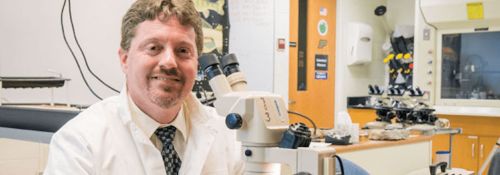
Dr. Anthony Swinehart
Written by Ian Atherton
By the time he was eight, Anthony Swinehart knew that he wanted to study aquatic biology. His determination was hardly surprising—he had spent the first years of his life fishing the waters of a nearby lake, where ample opportunities for adventure and investigation piqued the interest of a curious young boy. His determination was, however, challenged when his family left their lake and moved to a new slot of land in the Indiana countryside, where Swinehart’s only source of available water was a pond too stagnant and shallow to support fish.
His early years on the lake had made their mark, though, and Swinehart—by this time in high school—set to work detassling corn. He raised enough money to have his pond made suitable for a resident school of fish. In the meantime, he satiated his scientific curiosity by investigating the plants and microorganisms that thrived in the pond. By the time that his investigative work with a posthole digger uncovered eleven thousand year old fossils of pinecones and snails, this pond—once too shallow and lifeless to support a minnow—had become a fertile growing plot for the eager mind of a young scientist.
Swinehart would go on to earn his Bachelor’s degree in biology at Indiana’s Goshen College, a Master’s in Biology and Conservation at Central Michigan University, and a Ph.D. in Forestry and Natural Resources at Purdue University. Now, he is employed full-time as a professor of Aquatic Ecology and Paleoecology and Curator of the D.M. Fisk Museum at Hillsdale College.
His story really is fascinating—should you ever have the chance, I would recommend stopping by his office and hearing it for yourself. While you’re there, ask plenty of questions and pay attention to the room. You’ll find out that the trophy behind his desk has been passed between him and some of his former students for nearly a decade following a yearly fishing competition in northern Michigan (Swinehart’s name is etched into the side a full five times). The life-size cutout of Oakland Raider’s offensive tackle Jared Veldheer was a personal gift from the player’s father after Swinehart worked as an adviser on Jared’s senior thesis in the Florida Keys. Ask nicely, and Dr. Swinehart may even show a few fossils that he and his students have pulled from the ground in Massachusetts, Wyoming, South Dakota, Indiana, and Hillsdale itself.
But these things—the story, the trophies, and the artifacts—do not simply paint the background portrait of a man long dedicated to his craft. Rather, they comprise one of the latest chapters in the enduring legacy of Hillsdale’s biology department.
Swinehart tells me that Hillsdale underwent something of a scientific renaissance in the 1880’s, when Prof. Daniel Fiske founded the Harrington Biological Laboratory at the college. In Fiske’s time, American biology students very rarely participated in lab activities, instead merely observing the procedure as their professor performed it. Fiske’s laboratory was among one of the first in the nation to not only allow, but also to demand, the active participation of its students.
Now, Hillsdale continues this tradition by insisting that biology students conduct original research on a senior thesis. In order to graduate, they must publicly defend their work, much like students do at the masters and doctoral levels. Swinehart swears that this philosophy leads to amounts of graduate level work unprecedented for a small, undergraduate program like Hillsdale’s. It’s hard to argue with his results. It is not uncommon for Hillsdale’s students to have their work published in graduate-level journals, and Swinehart alone has acted as an advisor on thesis work that has spanned the nation. His students have studied paleoecological conditions to help restore wetlands after the decline of the Massachusetts cranberry industry, unearthed two mastodon skeletons, investigated the remains of an ancient and rare wetland in Indiana, and discovered 30,000-year-old spruce wood in a well-drilling. Others have conducted work in such diverse locations as the Florida Keys, Nebraska’s Henry Doorly Zoo, and South Africa.
Swinehart maintains that this sort of work is essential to a truly successful undergraduate biology program. “I came here for a reason,” he tells me, “they say that Hillsdale’s biology department is its best kept secret, but we’re trying our hardest to make sure that it’s not a secret much longer. Fiske started his lab, and it was one of the first of its kind. Now we’re continuing with that spirit by bringing the procedures to the students and by bringing the students to the field.”
Swinehart’s attitude is not surprising though—it is exactly the sort upon which the sciences depend. Discovery and innovation rarely wait on those who merely observe and do not investigate, thriving instead on the investigative dedication of students and their mentors. In any of these cases, there is always a story to be told, and, much like Dr. Swinehart’s, it is often set in motion by little more than a fishing pole, a posthole digger, and a question.
Ian Atherton is a Junior English Major from Denver, Colorado. Following graduation, he hopes to pursue a career in education.